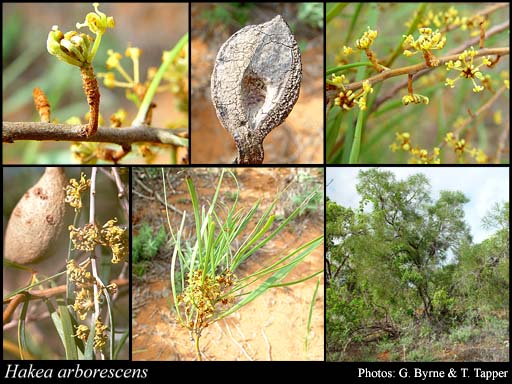- Reference
- Trans.Linn.Soc.London 10:187 (1810)
- Conservation Code
- Not threatened
- Naturalised Status
- Native to Western Australia
- Name Status
- Current
Tall shrub or tree, 2-7 m high, leaves flat, 1-9 mm wide; flower indumentum: white-pubescent, pedicel and claw, ferruginous on limb. Fl. cream-yellow, Jan to Jun. Basalt, laterite over basalt, sandstone.

Scientific Description
Trees or Shrubs, 2-7 m high; branchlets hairy. Leaves alternate, 50-170 mm long, 1-13 mm wide, glabrous; lamina flat, widest around the middle, entire. Inflorescences axillary, white or yellow; pedicels 3-4 mm long. Perianth 2-4 mm long, hairy; ovary glabrous; pistil 3-4.5 mm long, pollen presenter conical, style glabrous. Follicles 30-55 mm long, 16-30 mm wide, corky tetrahedral projections (on external surfaces of fruit) absent; seed 21-35 mm long (including wing), 7.5-13.5 mm wide, the wing discontinuous, apical. Flowers in January, February, March, April, May or June. Occurs in the Northern (N) Botanical Province(s), in the Northern Kimberley (NK), Victoria Bonaparte (VB), Central Kimberley (CK), Dampierland (DL) or Ord-Victoria Plains (OVP) IBRA subregion(s).
Distribution
- IBRA Regions
- Central Kimberley, Dampierland, Northern Kimberley, Ord Victoria Plain, Victoria Bonaparte.
- IBRA Subregions
- Berkeley, Fitzroy Trough, Hart, Keep, Mitchell, Mount Eliza, Pentecost, Pindanland, Purnululu, South Kimberley Interzone.
- IMCRA Regions
- Canning, Kimberley, King Sound.
- Local Government Areas (LGAs)
- Broome, Derby-West Kimberley, Halls Creek, Wyndham-East Kimberley.